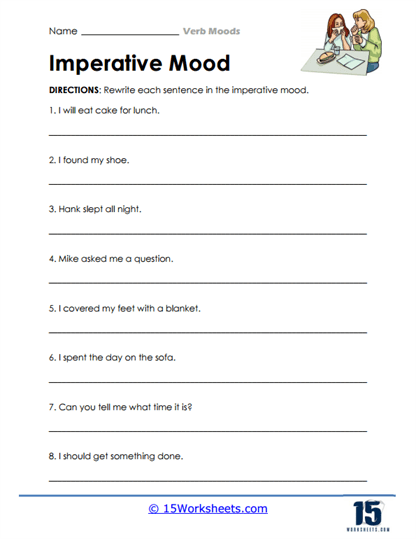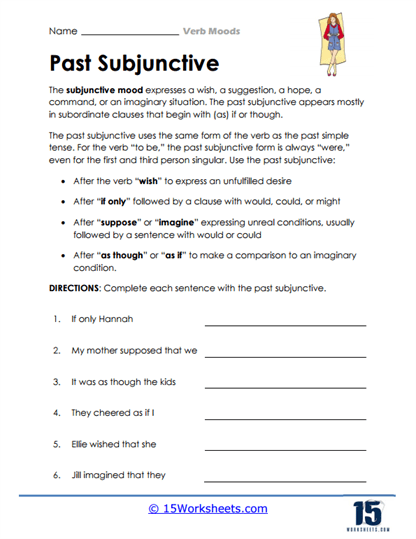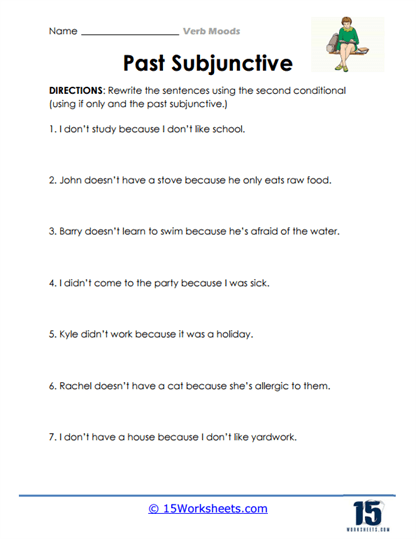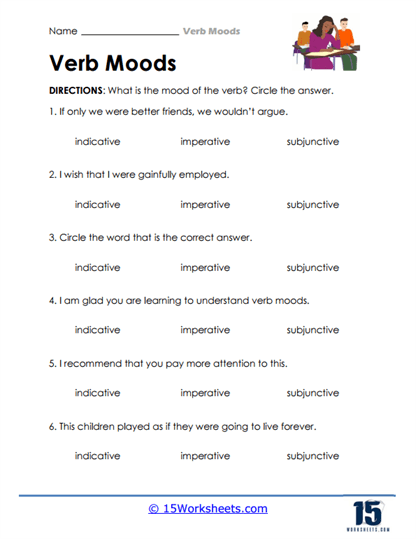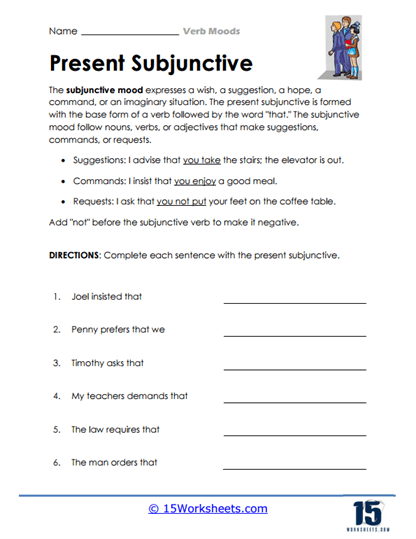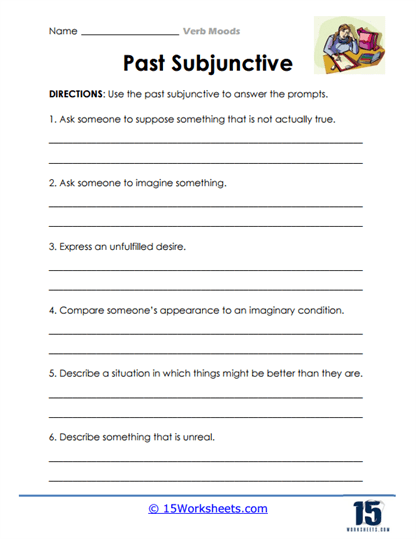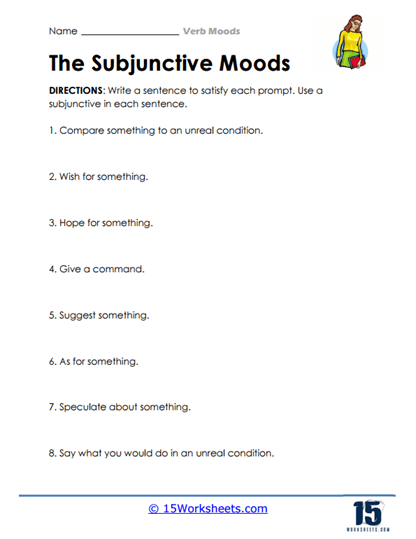Verb Moods Worksheets
About These 15 Worksheets
This collection of worksheets is a comprehensive resource designed to enhance students’ understanding of verb moods through diverse and engaging activities. These worksheets are tailored for students, teachers, and homeschoolers who seek to deepen their knowledge of the indicative, imperative, and subjunctive moods in English grammar. Each worksheet is crafted to build foundational skills, reinforce concepts, and challenge students to apply their knowledge in various contexts.
Indicative Mood Worksheets
The worksheets dedicated to the indicative mood focus on helping students identify and correctly use this most common verb mood. The indicative mood is used for statements of fact and certainty, making it a crucial aspect of everyday communication. Activities in these worksheets include:
Identification Exercises – Students are tasked with reading sentences and determining whether they are in the indicative mood. They write “indicative” on the line if the sentence fits the criteria, reinforcing their understanding of factual statements.
Sentence Pairing – In this exercise, students are presented with pairs of sentences and must choose which one is in the indicative mood. This activity sharpens their ability to distinguish between different verb moods and deepens their comprehension of when and how the indicative mood is used.
Sentence Rewriting – Students practice converting sentences into the indicative mood. This task encourages them to think critically about how to express ideas clearly and factually, solidifying their grasp of the indicative form.
Imperative Mood Worksheets
These worksheets are centered around the imperative mood, which is used for commands, requests, and instructions. Understanding the imperative mood is essential for effective communication in both written and spoken English. Activities include:
Command Identification – Students read sentences and determine if they are in the imperative mood. This exercise helps students become familiar with the direct, often concise language of commands.
Comparative Exercises – Students compare sentences within pairs, selecting the one that represents the imperative mood. This not only reinforces their understanding of commands but also helps differentiate imperative sentences from other moods.
Sentence Construction – Students are encouraged to write their own sentences in the imperative mood. This creative exercise allows them to practice giving instructions or commands, thereby improving their command of this verb mood.
Subjunctive Mood Worksheets
The subjunctive mood is often the most challenging for students to grasp because it is used less frequently in everyday language but remains essential for expressing wishes, hypotheticals, and conditions contrary to fact. These worksheets offer:
Sentence Conversion – Students are guided to rewrite sentences in the subjunctive mood. This activity helps them understand the nuances of expressing desires, hypotheticals, and recommendations.
Mood Identification – In this activity, students must identify the verb mood in a variety of sentences, distinguishing between the subjunctive, indicative, and imperative moods. This reinforces their overall understanding of verb moods and highlights the unique role of the subjunctive.
Creative Writing Prompts – These prompts encourage students to use the subjunctive mood in original sentences. By expressing wishes, suggestions, or hypothetical scenarios, students gain practical experience in applying the subjunctive mood.
All worksheets in this collection are available in PDF format, making them easy to view, download, and print. This ensures that both teachers and students can access the materials in a format that suits their needs, whether they are used in the classroom, at home, or on the go.
Through a variety of engaging and challenging activities, students will develop a deeper understanding of how to use the indicative, imperative, and subjunctive moods effectively. These worksheets not only support the learning of essential grammar skills but also encourage students to apply their knowledge creatively and confidently in both written and spoken communication.
What Are Verb Moods?
Verb moods are an essential aspect of English grammar that indicate the attitude or intent of the speaker or writer towards the action or state described by the verb. Essentially, verb moods help convey whether a statement is a fact, a command, a wish, a possibility, or a question. By using different verb moods, we can express various nuances in communication, which allows for more precise and effective language use.
The Indicative Mood
The most commonly used verb mood in English is the indicative mood. This mood is used to make factual statements, ask questions, or express opinions as facts. For example, sentences like “She walks to school every day,” “The sky is blue,” or “Do you understand the lesson?” are all in the indicative mood. The purpose of the indicative mood is to communicate information or state something that the speaker believes to be true. It is the default mood for most sentences because it deals with reality and objective facts.
The Imperative Mood
The imperative mood is used for issuing commands, making requests, or offering invitations. In this mood, the subject of the sentence is usually implied rather than explicitly stated, and the verb is in its base form. For example, in sentences like “Close the door,” “Please sit down,” or “Join us for dinner,” the speaker is directly addressing the listener and instructing them to do something. The imperative mood is vital in everyday communication because it enables us to give directions, make suggestions, or express desires in a concise and direct manner.
The Subjunctive Mood
The subjunctive mood is less commonly used but equally important. It is typically employed to express wishes, hypothetical situations, demands, or conditions that are contrary to fact. For instance, in sentences like “I wish I were taller,” “If I were you, I would apologize,” or “It is essential that he be present at the meeting,” the subjunctive mood indicates that the speaker is discussing something that is not necessarily real or is uncertain. The subjunctive mood helps convey ideas that are speculative, imaginary, or desired, allowing for more complex expressions of thought.
The Role of Verb Moods in Communication
Verb moods play a critical role in shaping the meaning and intent of our sentences. By selecting the appropriate mood, speakers and writers can accurately reflect their intentions, whether they are stating a fact, giving a command, or expressing a wish. Understanding and using verb moods correctly enhances clarity and precision in communication, making it easier for listeners and readers to understand the speaker’s or writer’s true intent.






